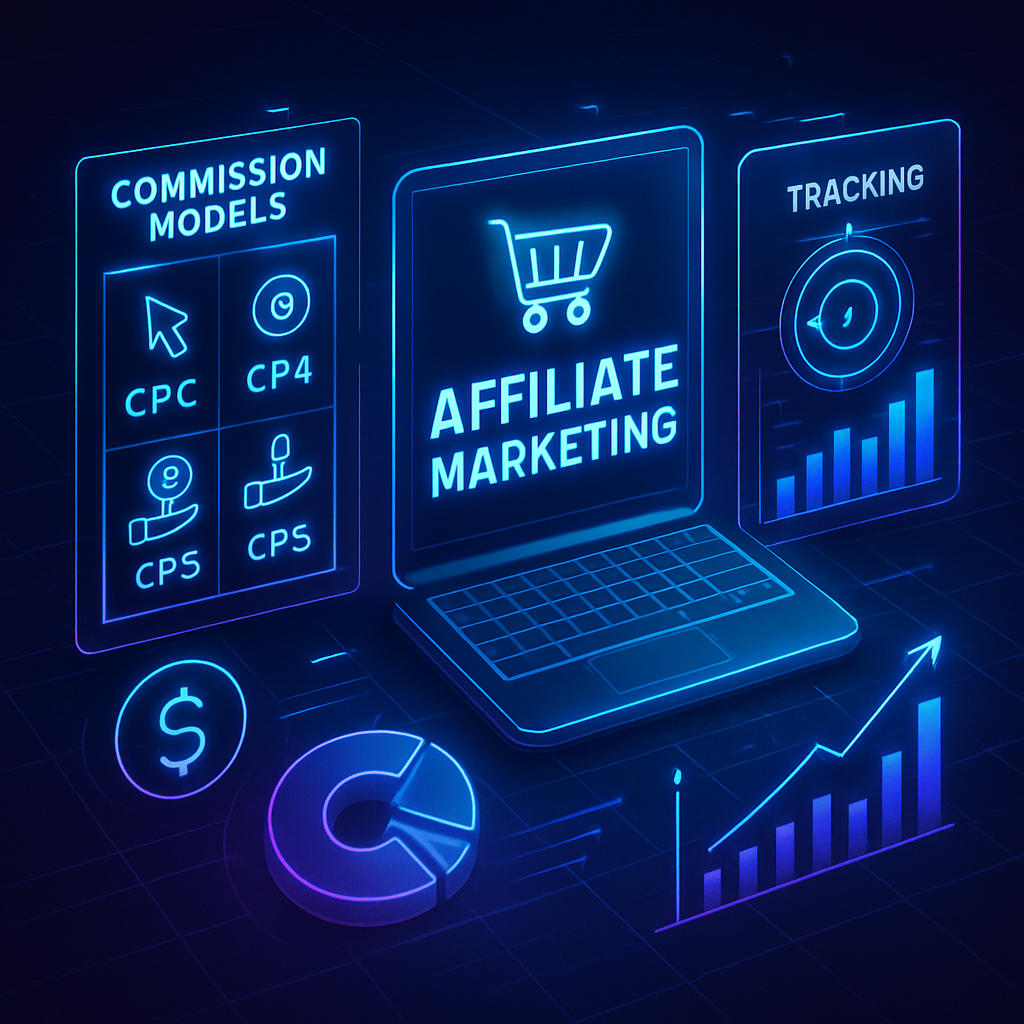In 2025, affiliate marketing stands at a crossroads of unprecedented opportunity and innovation. As digital ecosystems evolve, driven by AI advancements and shifting consumer behaviors, marketers and businesses can no longer rely on traditional tactics alone. Platforms such as TikTok, YouTube, Instagram, and emerging channels are transforming how affiliates engage audiences, creating new pathways to influence purchasing decisions.
Rapid technological progress means affiliate marketing is becoming more data-driven, transparent, and integrated into broader marketing strategies with a focus on authentic connections and measurable outcomes. Businesses leveraging diverse affiliate networks like Amazon Associates, ClickBank, ShareASale, and Rakuten Marketing are discovering the power of refined commission structures and advanced tracking systems that nurture partnerships and incentivize performance.
In this dynamic environment, success depends on adopting cutting-edge tools, understanding consumer journeys with multi-touch attribution, and partnering with micro-influencers and niche creators who drive authentic engagement. Entrepreneurs and marketing leaders alike must craft precise objectives, optimize content quality, and harness search engine consistency to thrive. This roadmap details the essential strategies, platforms, and metrics that will shape affiliate marketing success throughout this transformative year and beyond.
Understanding Affiliate Marketing and Commission Models Driving Success in 2025
Affiliate marketing continues to be a vital growth engine in digital business, enabling individuals and companies to earn commissions by promoting products or services offered by others. Affiliates, ranging from bloggers to social media influencers and website owners, employ unique tracking links that attribute sales or actions back to their promotion efforts. When consumers take an action — like purchasing or signing up — the affiliate earns compensation, usually within predefined commission schemes.
Commission Structures Explained
Successful affiliate marketing is heavily influenced by the commission model, aligning incentives between merchants and affiliates. The main types include:
- Cost Per Action (CPA): Affiliates are rewarded for specific user actions such as purchases, registrations, or form completions. This model commonly drives campaigns emphasizing conversions.
- Pay Per Click (PPC): Commissions depend on the number of clicks an affiliate generates, independent of purchase outcomes. Less common but effective for traffic-heavy promotions where leads are nurtured post-click.
- Revenue Sharing or Cost Per Sale (CPS): Affiliates receive a percentage of the sale value when successful transactions occur. Predominantly utilized for product reviews, email marketing, and sustained campaigns, this model incentivizes affiliates towards quality traffic and high conversion rates.
Each commission model has benefits depending on the merchant’s goals and affiliate’s style. In 2025, optimizing commission schemes is essential, as companies explore hybrid models blending fixed fees, performance bonuses, and tiered rewards to motivate top-tier affiliates while sustaining profitability.
Top affiliate programs continue to refine tracking accuracy to safeguard commissions and maintain trust. Platforms like Amazon Associates offer broad product ranges but apply variable commission rates, typically modest for physical goods but leveraging Amazon’s conversion credibility. Conversely, ClickBank excels with digital products, providing high commissions up to 75%, often rewarding ongoing subscription referrals.
Affiliate Marketing Ecosystem Key Players
Affiliate marketing involves four crucial participants:
- Merchant (Advertiser/Brand): The business offering products or services for affiliates to promote.
- Affiliate (Publisher/Marketer): Individuals or companies driving traffic to merchant offers.
- Consumer: The end-user who completes the desired action, like a purchase.
- Affiliate Network: Optional intermediaries such as ShareASale, CJ Affiliate, and Rakuten Marketing that connect merchants with affiliates, providing tracking, reporting, and payment management.
Understanding these roles helps businesses build strong partnerships with top-performing affiliates and select reliable networks that align with their goals. For example, Impact and FlexOffers also cater to diverse niches, offering detailed analytics which are critical for scaling affiliate operations and refining strategies based on actionable insights.
| Affiliate Program | Commission Model | Key Strengths | Average Commission Rate | Best Suited For |
|---|---|---|---|---|
| Amazon Associates | CPS (Variable) | Huge product assortment, trusted platform | 1-10% | Physical products and general niches |
| ClickBank | CPS / Recurring | High commissions, digital products focus | 25-75% | Info-products, subscriptions |
| ShareASale | Mixed (CPA, CPS) | Large merchant base, transparent reporting | Varies per merchant | Wide industry coverage |
| Rakuten Marketing | Performance-based with multi-channel attribution | Enterprise solutions, deep-linking | Varies | Global brands, high-value offers |
Choosing the right affiliate program means matching your niche and audience with a network offering competitive commissions, reliable tracking, and quality merchant partnerships. For more guidance, consult resources like how to choose the right affiliate program.

Embracing AI Technologies and Social Commerce: The Evolution of Affiliate Marketing in 2025
Affiliate marketing in 2025 is rapidly reshaped by artificial intelligence, social commerce, and enhanced data privacy regulations. Brands and marketers who harness these trends strategically can unlock significant competitive advantage.
AI-Driven Automation and Analytics
Artificial intelligence now automates content creation, optimizes campaigns, and offers predictive analytics to identify the most promising affiliate partnerships. AI-generated keyword research, dynamic ad placements, and even personalized product recommendations are becoming standard features in sophisticated affiliate programs.
For example, AI tools can analyze consumer behavior patterns to forecast which affiliates will drive the best ROI, streamlining recruitment and budget allocation. Marketers use these insights to create hyper-segmented campaigns, dramatically improving conversion rates.
The Surge of Social Media-Driven Affiliate Sales
Social commerce is transforming affiliate marketing, with platforms like TikTok, YouTube, and Instagram creating immersive environments for product discovery and purchase. Short-form video content, influencer collaborations, and integrated shopping features allow affiliates to engage audiences in authentic, interactive ways.
- TikTok: Viral trends and short videos enable rapid reach expansion. Creators often link affiliate products through shoppable posts or live streams.
- YouTube: In-depth reviews, tutorials, and unboxing videos provide long-lasting content that generates steady affiliate referrals.
- Instagram: Features like Reels, Stories, and in-app checkout simplify the buying process while showcasing products visually.
Partnering with micro-influencers, who command highly engaged niche audiences, makes campaigns more credible and cost-effective compared to broad celebrity sponsorships. This approach mirrors the evolving consumer preference for genuine recommendations.
Moreover, stricter privacy rules and cookie restrictions demand first-party data strategies and transparent tracking. Affiliate programs are incentivized to adopt robust, privacy-compliant tools that maintain accurate attribution while respecting consumer rights.
| Technology | Impact on Affiliate Marketing | Best Use Cases |
|---|---|---|
| AI Automation | Optimizes targeting, content creation, and predictive analytics | Enhancing campaign ROI and identifying high-value affiliates |
| Social Commerce | Facilitates seamless affiliate-driven purchases on social platforms | Maximizing conversion with influencer collaborations and shoppable content |
| Privacy-First Tracking | Mitigates loss from cookie restrictions, enforces transparent attribution | Ensuring fair affiliate compensation and consumer trust |
Affiliate marketers interested in upgrading their tools and approaches can find valuable strategies at affiliate marketing strategies that work in 2025 and boost your earnings with these affiliate marketing techniques.
AI-powered tools are a game-changer to scale marketing efforts while maintaining authenticity and engagement, critical for long-term affiliate program success.
How to Build a Winning Affiliate Marketing Program in 2025
Building a profitable affiliate marketing program requires clear planning and execution. Business leaders looking to scale affiliate initiatives should focus on integrating affiliate efforts with overall marketing strategies and maintaining strong, mutually beneficial relationships with affiliates.
Steps to Boost Company Affiliate Marketing
- Set Clear Objectives and KPIs: Define revenue goals, customer acquisition costs, and conversion benchmarks to guide program decisions.
- Choose Appropriate Platforms: Decide between managing an in-house program or leveraging networks like ShareASale, CJ Affiliate, or Awin for broader reach and infrastructure support.
- Develop Competitive Commission Tiers: Reward top performers with scalable commissions and incentives.
- Create Affiliate-Ready Assets: Provide high-converting landing pages, banners, and content affiliates can easily use to promote products effectively.
- Implement Advanced Tracking and Attribution: Deploy multi-touch attribution models and robust analytics to fairly reward affiliate contributions and optimize campaigns.
- Recruit the Right Affiliates: Focus on influencers and content creators aligned with your target audience for authentic marketing messages.
- Integrate Program with Other Marketing Channels: Ensure seamless user experiences by linking affiliate promotions with email marketing, social media campaigns, and SEO efforts.
The Italian company Eataly serves as a compelling example, successfully blending cultural heritage with modern retail innovation and affiliate partnerships to expand internationally. They emphasize sustainability and authentic storytelling, principles that are highly effective in today’s affiliate marketing landscape.
For content creators and affiliates looking to deepen their impact, exploring creating effective content for affiliate marketing success is crucial.
| Step | Details | Expected Outcome |
|---|---|---|
| Set Objectives | Define clear KPIs such as revenue and conversion goals | Guided program optimization and measurable success |
| Platform Selection | Choose between networks or in-house management | Access to technology, partners, or direct control |
| Commission Structure | Create scalable, tiered systems to motivate affiliates | Increased affiliate engagement and performance |
| Content Assets | Develop affiliate-ready marketing materials | Higher conversion rates and consistent messaging |
| Tracking Setup | Implement multi-touch attribution and detailed reporting | Fair rewards and enhanced data insights |
| Affiliate Recruitment | Focus on niche influencers with aligned audiences | Authentic promotion and brand affinity |
| Channel Integration | Link affiliate efforts to broader marketing campaigns | Improved customer experience and amplified reach |

Measuring and Optimizing Affiliate Marketing Performance for Maximum Impact
Data-driven decision making lies at the core of affiliate marketing success in 2025. Regularly tracking and analyzing key performance indicators (KPIs) enables marketers to identify areas for improvement and ensure sustainable growth.
Key Metrics to Monitor
- Conversion Rate: Measures the percentage of referred visitors completing purchase or other goals, reflecting traffic quality.
- Average Order Value (AOV): Tracks revenue per sale from affiliate traffic, helping target higher-value partners.
- Cost per Acquisition (CPA): Compares the cost of affiliate commissions to customer acquisition efficiency.
- Return on Ad Spend (ROAS): Assesses revenue generated relative to affiliate payout costs, indicating financial viability.
- Customer Lifetime Value (CLV): Evaluates the long-term profitability of customers obtained through affiliates.
- Active Affiliate Ratio: Percentage of engaged affiliates versus total enrolled, highlighting recruitment effectiveness.
- Traffic Quality Indicators: Metrics such as bounce rate and session duration expose traffic engagement levels.
- Attribution Accuracy: Tracks multi-touch contributions to ensure proper payout and identify powerful affiliate touchpoints.
- Mobile vs. Desktop Performance: Reveals device-centric conversion trends to optimize user experience accordingly.
- Commission to Revenue Ratio: Ensures affiliate payouts remain sustainable in line with generated sales.
| Metric | Purpose | Actionable Insight |
|---|---|---|
| Conversion Rate | Assess affiliate traffic quality | Prioritize affiliates with higher conversion rates |
| Average Order Value | Identify high-value customer sources | Adjust commission tiers to reward quality sales |
| Cost per Acquisition | Evaluate cost-efficiency of affiliate marketing | Compare with other marketing channels for budget allocation |
| Return on Ad Spend | Measure program profitability | Scale campaigns yielding positive ROAS |
| Customer Lifetime Value | Understand long-term value of customers | Invest in affiliates delivering sustained profitability |
| Active Affiliate Ratio | Monitor affiliate engagement | Re-engage or replace inactive affiliates |
Employing data visualization and attribution analytics helps marketers paint a holistic picture of the affiliate program’s health. For deeper guidance on tracking affiliate success, visit track affiliate marketing.
Frequently Asked Questions About Affiliate Marketing Success in 2025
- Can I generate passive income through affiliate marketing?
Yes, affiliate marketing offers a pathway to passive income. However, success hinges on choosing the right niche, producing quality content, and consistent marketing efforts. For beginners, platforms like Amazon Associates and ClickBank provide accessible entry points. - Which affiliate networks offer the best commission structures?
Commission rates vary by industry, product, and platform. ClickBank is renowned for high commissions on digital products, sometimes exceeding 75%. Amazon Associates offers broader marketplace exposure but lower rates, while networks like ShareASale and CJ Affiliate provide diverse options across categories. - How are affiliate commissions tracked in the age of privacy regulations?
Networks use tracking links, cookies, and increasingly, first-party data tracking to attribute sales. The shift towards privacy-first technologies requires marketers to partner with networks employing transparent, compliant tracking solutions. - What ongoing trends should affiliates watch in 2025?
Emerging trends include AI-powered content automation, social commerce expansion, micro-influencer marketing, and sophisticated multi-touch attribution. Staying current ensures sustained relevance and maximizes earning potential. - How do I select the best affiliate program for my business or blog?
Select a program matching your audience’s interests, offering reliable payouts, and providing marketing support. Resources such as how to choose the right affiliate program can aid in making informed decisions.


